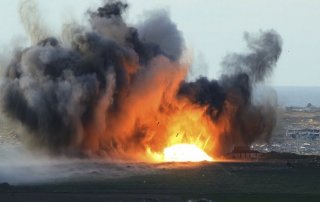Watch a B-2 Bomber Drop a Warhead and Decimate All Below
"Bunker buster."
Here's What You Need to Remember: The GBU-57 is arguably the most destructive weapon of its kind, hailing from a long line of smaller cousins and air blast variants.
The B-2 Spirit is the most advanced strategic bomber in the US Air Force (USAF) roster, occupying a vital role in the American nuclear triad for its blend of deep penetration and heavy ordnance delivery capabilities.
There has been no shortage of B-2 footage over the past several decades, extensively capturing its takeoff and maintenance routines as well as a wide range of aerial shots. However, there has been a curious dearth of B-2 weapons exercise clips-- until now.
Last week, the US Air Force posted a two-minute long video of the B-2 dropping GBU-57A/B “bunker buster” bombs from a past training event. The clip, shot with an unusually high video fidelity for a military exercise, shows a B-2 opening its internal weapons bay to drop two GBU-57 massive ordnance penetrator (MOP) bombs. One of the bombs drills into the earth beneath the designated area, marked with a red cone, before detonating in a powerful explosion with good effect on target (GEOT).
As depicted in the video, the GBU-57 is designed to penetrate fortifications up to 200 feet below ground before detonating its 5,300-pound warhead, clearing out enemy positions that are otherwise unreachable by surface-level bombing runs.
The GBU-57 is arguably the most destructive weapon of its kind, hailing from a long line of smaller cousins and air blast variants. When combined with the infiltration capabilities of the B-2 Spirit, MOP provides the US military with a robust toolkit for neutralizing enemy underground structure of the kind widely used by the North Korean and even Chinese militaries.
The latest iteration of MOP-- the GBU-57/B-- is slated to fix its predecessor’s most crucial shortcoming: its fuze system. The detonation fuze of prior models was prone to triggering before or after reaching the target, or not denoting at all. The US military is currently in the process of upgrading their MOP arsenal to “smarter fuzes,” capable of counting layers, resisting several feet of concrete impact, and even transmitting mission information back to military command.
Aside from the changes to the Fuze mechanism, Boeing engineers have worked to mitigate the effects of ground impact through sheer size and mass; coming in at a whopping 30,000 pounds and with a 32-inch diameter, GBU-57’s warhead is encased in a massive hunk of protective steel as it burrows toward its target.
The B-2, while not getting any younger from its 1997 debut, is anything but a slouch in the heavy bomber stealth performance department. It likewise features a remarkable viable avionics package for its day, boasting a coterie of digital displays (including a Synthetic Aperture Radar). Nonetheless, anti-air missile technology has advanced dramatically over the past two decades; Russia has since introduced its capable S-400 system, which is now on the cusp of being succeeded by the upcoming S-500.
As such, the USAF plans to modernize the B-2 platform over the coming decades while retaining the core performance features that have made it America’s staple heavy nuclear bomber. The ongoing B-2 modernization program is focused around a deep avionics overhaul, integrating a new flight management control processor and “Defense Management System (DMS),” a collection of sensors calibrated to reveal the precise location of enemy anti-air systems.
Mark Episkopos is a frequent contributor to The National Interest and serves as research assistant at the Center for the National Interest. Mark is also a PhD student in History at American University. This article first appeared in 2019 and is reprinted here due to reader interest. Image: YouTube

